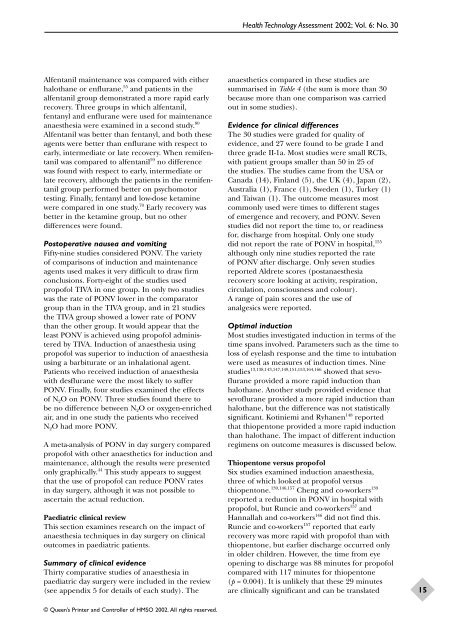Aanesthetic Agents for Day Surgery - NIHR Health Technology ...
Aanesthetic Agents for Day Surgery - NIHR Health Technology ...
Aanesthetic Agents for Day Surgery - NIHR Health Technology ...
You also want an ePaper? Increase the reach of your titles
YUMPU automatically turns print PDFs into web optimized ePapers that Google loves.
Alfentanil maintenance was compared with either<br />
halothane or enflurane, 55 and patients in the<br />
alfentanil group demonstrated a more rapid early<br />
recovery. Three groups in which alfentanil,<br />
fentanyl and enflurane were used <strong>for</strong> maintenance<br />
anaesthesia were examined in a second study. 80<br />
Alfentanil was better than fentanyl, and both these<br />
agents were better than enflurane with respect to<br />
early, intermediate or late recovery. When remifentanil<br />
was compared to alfentanil 59 no difference<br />
was found with respect to early, intermediate or<br />
late recovery, although the patients in the remifentanil<br />
group per<strong>for</strong>med better on psychomotor<br />
testing. Finally, fentanyl and low-dose ketamine<br />
were compared in one study. 70 Early recovery was<br />
better in the ketamine group, but no other<br />
differences were found.<br />
Postoperative nausea and vomiting<br />
Fifty-nine studies considered PONV. The variety<br />
of comparisons of induction and maintenance<br />
agents used makes it very difficult to draw firm<br />
conclusions. Forty-eight of the studies used<br />
propofol TIVA in one group. In only two studies<br />
was the rate of PONV lower in the comparator<br />
group than in the TIVA group, and in 21 studies<br />
the TIVA group showed a lower rate of PONV<br />
than the other group. It would appear that the<br />
least PONV is achieved using propofol administered<br />
by TIVA. Induction of anaesthesia using<br />
propofol was superior to induction of anaesthesia<br />
using a barbiturate or an inhalational agent.<br />
Patients who received induction of anaesthesia<br />
with desflurane were the most likely to suffer<br />
PONV. Finally, four studies examined the effects<br />
of N 2O on PONV. Three studies found there to<br />
be no difference between N 2O or oxygen-enriched<br />
air, and in one study the patients who received<br />
N 2O had more PONV.<br />
A meta-analysis of PONV in day surgery compared<br />
propofol with other anaesthetics <strong>for</strong> induction and<br />
maintenance, although the results were presented<br />
only graphically. 44 This study appears to suggest<br />
that the use of propofol can reduce PONV rates<br />
in day surgery, although it was not possible to<br />
ascertain the actual reduction.<br />
Paediatric clinical review<br />
This section examines research on the impact of<br />
anaesthesia techniques in day surgery on clinical<br />
outcomes in paediatric patients.<br />
Summary of clinical evidence<br />
Thirty comparative studies of anaesthesia in<br />
paediatric day surgery were included in the review<br />
(see appendix 5 <strong>for</strong> details of each study). The<br />
© Queen’s Printer and Controller of HMSO 2002. All rights reserved.<br />
<strong>Health</strong> <strong>Technology</strong> Assessment 2002; Vol. 6: No. 30<br />
anaesthetics compared in these studies are<br />
summarised in Table 4 (the sum is more than 30<br />
because more than one comparison was carried<br />
out in some studies).<br />
Evidence <strong>for</strong> clinical differences<br />
The 30 studies were graded <strong>for</strong> quality of<br />
evidence, and 27 were found to be grade I and<br />
three grade II-1a. Most studies were small RCTs,<br />
with patient groups smaller than 50 in 25 of<br />
the studies. The studies came from the USA or<br />
Canada (14), Finland (5), the UK (4), Japan (2),<br />
Australia (1), France (1), Sweden (1), Turkey (1)<br />
and Taiwan (1). The outcome measures most<br />
commonly used were times to different stages<br />
of emergence and recovery, and PONV. Seven<br />
studies did not report the time to, or readiness<br />
<strong>for</strong>, discharge from hospital. Only one study<br />
did not report the rate of PONV in hospital, 155<br />
although only nine studies reported the rate<br />
of PONV after discharge. Only seven studies<br />
reported Aldrete scores (postanaesthesia<br />
recovery score looking at activity, respiration,<br />
circulation, consciousness and colour).<br />
A range of pain scores and the use of<br />
analgesics were reported.<br />
Optimal induction<br />
Most studies investigated induction in terms of the<br />
time spans involved. Parameters such as the time to<br />
loss of eyelash response and the time to intubation<br />
were used as measures of induction times. Nine<br />
studies 13,138,143,147,149,151,153,164,166 showed that sevoflurane<br />
provided a more rapid induction than<br />
halothane. Another study provided evidence that<br />
sevoflurane provided a more rapid induction than<br />
halothane, but the difference was not statistically<br />
significant. Kotiniemi and Ryhanen 148 reported<br />
that thiopentone provided a more rapid induction<br />
than halothane. The impact of different induction<br />
regimens on outcome measures is discussed below.<br />
Thiopentone versus propofol<br />
Six studies examined induction anaesthesia,<br />
three of which looked at propofol versus<br />
thiopentone. 139,146,157 Cheng and co-workers 139<br />
reported a reduction in PONV in hospital with<br />
propofol, but Runcie and co-workers 157 and<br />
Hannallah and co-workers 146 did not find this.<br />
Runcie and co-workers 157 reported that early<br />
recovery was more rapid with propofol than with<br />
thiopentone, but earlier discharge occurred only<br />
in older children. However, the time from eye<br />
opening to discharge was 88 minutes <strong>for</strong> propofol<br />
compared with 117 minutes <strong>for</strong> thiopentone<br />
(p = 0.004). It is unlikely that these 29 minutes<br />
are clinically significant and can be translated<br />
15
















